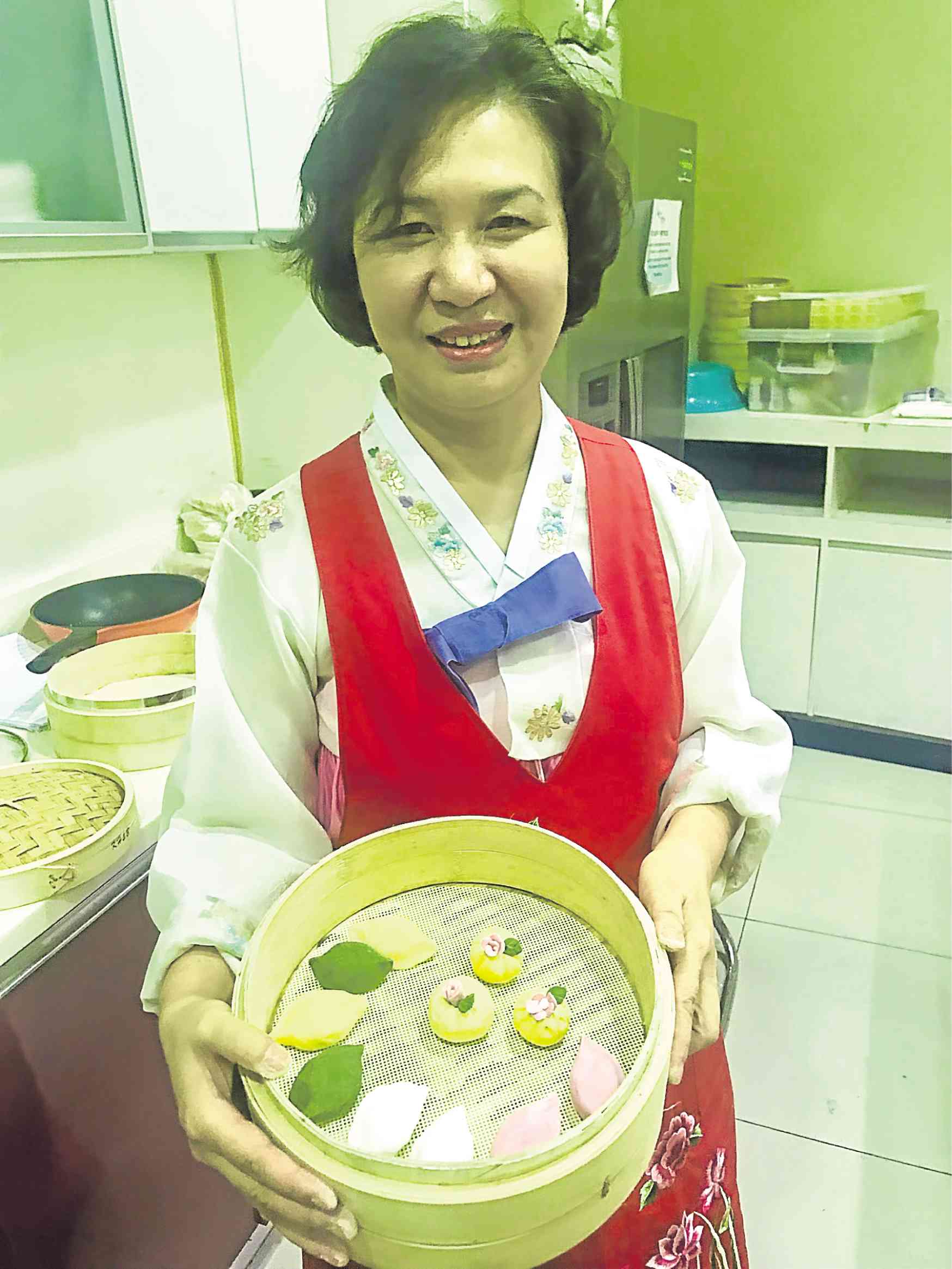
Korean rice cakes) for Chuseok or thanksgiving
On the occasion of Chuseok, the Korean Thanksgiving holiday, Korean food expert Lily Min taught me how to make songpyeon paired with baesuk.
Songpyeon is the traditional rice cake usually made during harvest festivals. It is made with rice powder and depending on the region, the stuffing and shape usually vary.
The most common songpyeon are half-moon shaped with nutritious fillings like beans, chestnuts and sesame seeds.
What makes this rice cake distinct is that it is steamed over a bed of pine needles (song in songpyeon means pine tree). The pine is what gives these beautiful bite-size treats their special flavor and aroma.
According to Min, it is a family tradition to make songpyeon on the eve of Chuseok. “We believe that the one who makes the most beautiful songpyeons will meet a good spouse or give birth to a beautiful child,” she said.
The rice cakes go well with baesuk, a cooked pear drink. Min said that because there is too much food during the Korean holiday, a digestive is needed. Baesuk is not only good for digestion and constipation but is also a natural remedy for cough and cold.
Harvest fest
The harvest moon, the largest full moon of the year, appears on the 15th day of the eighth month. This year Chuseok Day was celebrated on Sept. 24.
Director Lee Jincheol of the Korean Cultural Center described Korean Thanksgiving as “the biggest eating day of the year, to celebrate the good harvest.”
Festivities begin with ceremonies and offerings for ancestors followed by the preparation of food to be shared with family, friends, neighbors and the community.
“It is a day of sharing,” Lee said. “Many dress in traditional hanbok, and we play games and give money to the children,” he added.

Below are the recipes from the workshop.
Songpyeon
Prepare 2½ cups of Korean rice. Soak rice in cold water for 5-6 hours. Drain.
Use a blender and grind the soaked rice until you get fine rice powder.
Add 2 tbsp of hot water per cup of rice powder.
Add 2 tbsp of powder: mugwort, strawberry, green tea, raspberry, beet, hibiscus (any flavoring of choice in powdered form for flavor and color).
Adjust measurement of powder based on taste and color.
(Min suggested malunggay powder as a wonderful alternative to mugwort.)
Knead until the dough is smooth and evenly colored.
Roll dough into batons and cut off 20-25 g pieces and shape into balls.
Make a small hole with your thumb in the middle of the dough and fill with stuffing of your choice.
Seal the hole by pressing the edges of the dough.
Form to make half moon-shaped rice cakes.
Bring water in a steamer to a running boil and steam dumplings for 20 minutes
Drop rice cakes in a bowl of cold water for a quick rinse.
Quickly drain water by placing dumplings in a colander.
Coat hands with the sesame oil mixture and roll songpyeon for sheen and flavor.
Oil mixture:
1 tsp sesame oil
1/3 tsp salt
Mix to combine.
Sesame filling:
1 c sesame seeds
2 tbsp sugar
2 tbsp honey
1/3 tsp salt
Crush the sesame seeds roughly. Mix the sesame seeds with sugar and honey.
Mung bean filling:
1 c mung bean
1/4 c sugar
1/3 tsp salt
Soak peeled mung beans in cold water for 5-6 hours.
Steam the mung beans for 20 minutes.
Mash the mung beans and stir-fry with sugar and salt until dry.
Baesuk (Korean pear drink)
½ Korean pear
½ tsp whole black peppercorn
30 g ginger
¾ c sugar
2 L water
½ tbsp pine nut
Peel the Korean pear. Cut in half and set aside.
Cut the halved pear into 1/4 inch thick slices
Make small flowers using a small flower cutter.
Soak the whole peppercorns in hot water for 30 minutes. Embed the black peppercorn into the center of the pear flower.
Put the sliced ginger into a pot and add the water.
Boil the ginger with the remaining half-pear and leftovers (pear trimming from the flowers) over medium high heat for 20 minutes. Remove ginger and pear pieces.
Add the flower-shaped pears and sugar. Boil over low heat for about 10 minutes. Let it cool and store in the refrigerator.
Pour the liquid in serving cups. Garnish with pear flowers and 2-3 pine nuts when serving.
Call 5551711; visit https://phil.korean-culture.org/m/en/welcome.








































